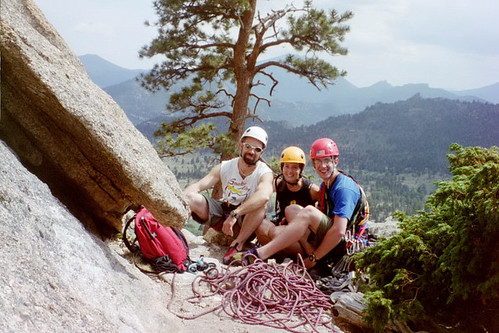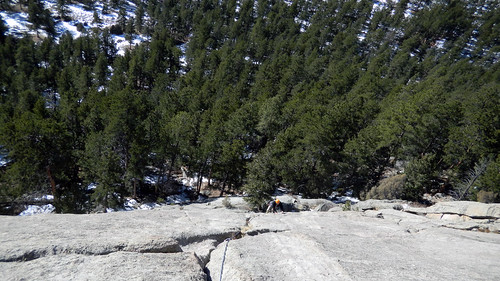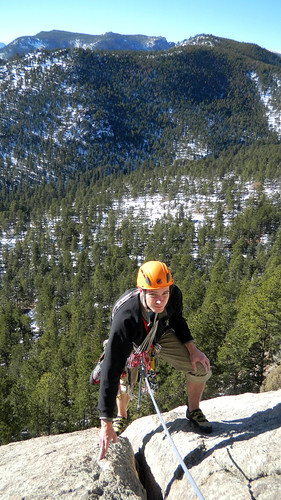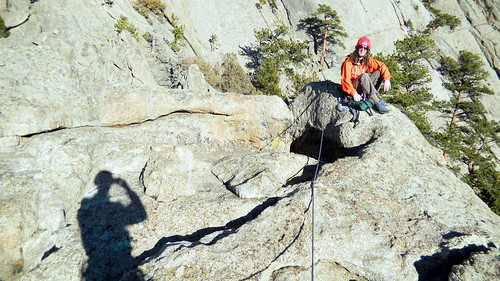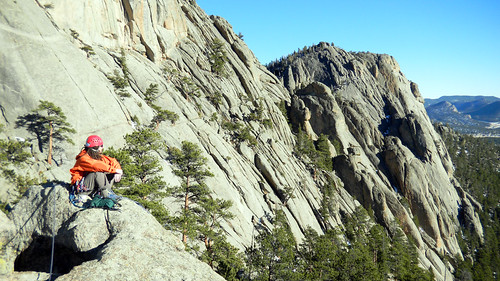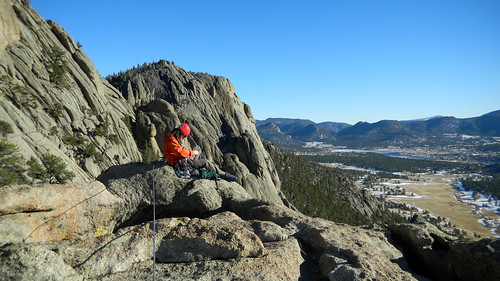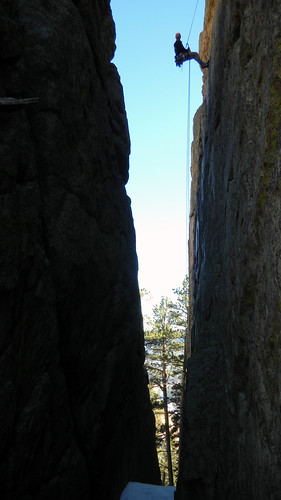Over the cold months I have been thinking of the ultimate pack for climbing. Now, I know that is a pretty bold claim and am well aware that my "ultimate pack" is considerably different than what others will consider to be ultimate. Before you start booing me let me give some background on why I consider this to be the end-all climbing pack (kind of).
Living in Estes Park, I find that I spend a considerable amount of time climbing up at Lumpy Ridge. Typically the routes I like to climb are longer than a pitch and require a walk off. Further, it should be noted that I am a slow climber and hate to get up early. If you combine these variables with typical Colorado summer weather (storms in the afternoon) you may start to see how my climbs usually culminate: hunkering down on a ledge hoping that I don't get hit by lightening, followed by a downhill suffer-fest descent in my too-tight climbing shoes. During the colder months I get to trade the fear of lightening for shivers and enjoy the added element of snow on the walk-off. If you have not experienced wading though snow in your climbing shoes you should definitely try it. It will change your life.
So now imagine you are standing at the bottom of a climb that may take 2-6 hours. The weather is either A) looking like it may storm or B) warm enough when you are moving but induces tremors when sitting. The descent is a steep, loose gully that may or may not have snow in it. Harder men than I will simply say climb fast and quit your whining. I am not a hard man so I am stuck with either trying to hang my jacket and shoes off my harness (fail) or wearing my approach pack containing only a pair of shoes and a jacket (awkward).
This very situation was presented to me last November while standing at the base of the Pear. As usual I opted for the hard-man approach. And, as usual, it sucked. During the walk out when the shivering had stopped and I had regained feeling in my feet I decided there had to be a better way. I poked around Neptune's, checking out the climbing packs but none of them really matched what I wanted. I wanted something that will simply carry my descent shoes, a jacket, and perhaps a headlamp but does not require me to carry two packs to go climbing. I wanted a something that was a pack when I needed to to be but otherwise took up very little space or weight.
Thus an idea was spawned. Why not make my own pack? I have been messing around with sewing my own lightweight backpacking gear so why not apply that to my climbing pack? The specs were simple:
1) Must be able to carry my Chaco's in the summer, approach tennies in the spring/fall, and boots in the winter
2) Must be able to carry my rain jacket in the summer, soft shell in the spring/fall, and down vest or polartec jacket in the winter (I wear my soft shell while climbing in the winter)
3) Must not interfere with my sissy-sized (i.e. large) trad rack or chalk bag and must not hinder arm movement.
So the R&D began and I quickly realized that the shoes could be used to create the frame of the pack if packaged correctly. Further, I wanted the shoes as near to my back as possible since they will be the heaviest item in the pack. I ended up with a "burrito" style closure with heavy duty velcro, directly inspired by Timbuc2 messenger bags. It was important that I could get to the jacket without accidentally dropping the shoes, so the shoes are buckled to the pack while the jacket (and headlamp if needed) is stuffed into a large pocket on one of the closure flaps. All this is packaged up nicely with a top and bottom lid and sealed with one of those awesome and indestructible Metolius buckles that you find on their crash pads. For materials I used Cordura 1000d (green) for the outside and 330d (black) for the inside. This pack may stop a bullet. I also added some wicking fabric to the parts of the pack that touch me. Finally I added a strong attachment point (the red loop) and quick release buckles to the shoulder straps. I went back and forth on the buckles quite a bit. Last thing I want is for this pack to fall off in the middle of a climb. Ultimately I decided that it would be pretty unlikely for both buckles to come undone and it would make it easier to remove the pack if I had thrown a bunch of slings over my shoulder. Plus, the pack is so short that it is sometimes hard to get it your arm in and out of the shoulder strap, especially when squeezed onto a small belay ledge.
OK, enough chit-chat. Lets get some eye candy. Here is what the pack looks like for my summer set-up. It will carry my trusty Chaco's (with the gum for emergency situations) and my Mt Hardwear Epic rain jacket on the left. I could easily add a cliff bar and a headlamp also. Note the sandals are securely strapped in and will not fall out when accessing the pocket.
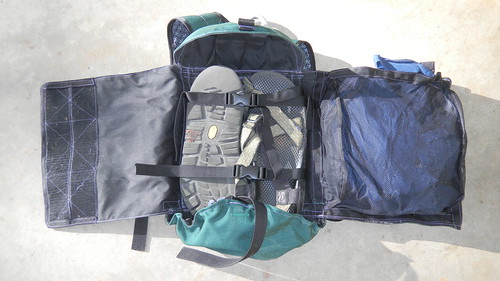
To seal up the pack you flip the jacket flap over the shoes like this:
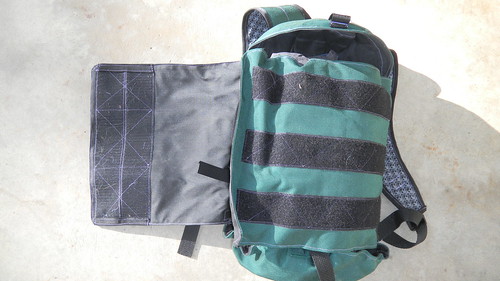
The flip the other flap over and seal it up with the buckle. It this pic you can also see the strong attachment point and the wicking fabric on the inside of the shoulder straps.
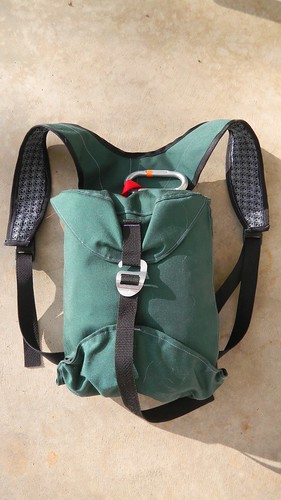
And finally a couple pics of me looking awkward while wearing the pack. Note how is rides high so as not to interfere with my harness/chalk bag and is narrow enough to not limit my arm movements. Note to self, need to shorten that strap. In the second pic, it looks like I did not have it tightened up enough. It is kind of low. But it shows how thick the pack is.
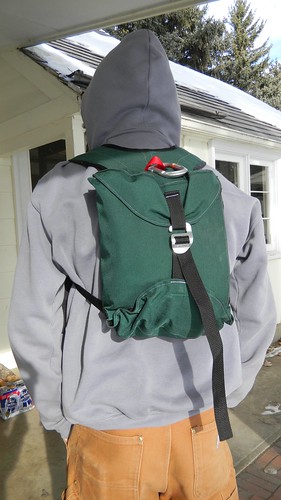
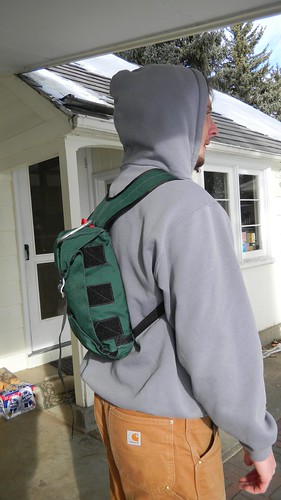
I found that I can kind of turn it inside out and make a nice little package with it. Not sure the final weight but it is quite light and packs down nicely. I would say it is comparable to my Patagonia Ascensionist softshell, which weighs in at 18 oz. Here are a couple pics of the pack when not in use.
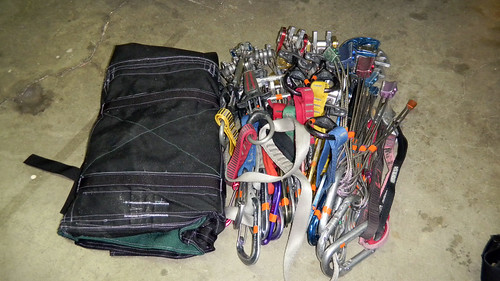
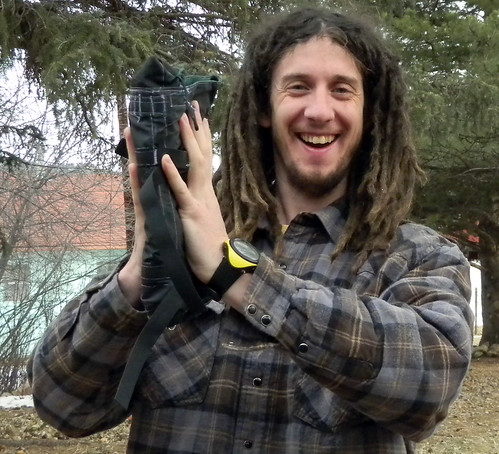
Well, theory is great but what about practical application? I guess I'll have to go out and climb something. Bummer! Since I was inspired on the Pear, I though it was only fitting to try it out on the Pear. Fortunately, we got a perfect January day last Tuesday. 50 degrees, no clouds and only a bit of wind. Gotta love winters in Colorado. It was exactly what the pack was designed for. I had my tennies for the approach and descent, both of which had quite a bit of snow to negotiate. On the descent we were wading through knee deep snow in the corridor behind the Pear. It would of been rough in climbing shoes, especially since the route was about 700' long. For a jacket, I had my Patagonia Ascensionist softshell. Which also worked out perfect because the wind kicked up. Here is a pic of the pack before liftoff.
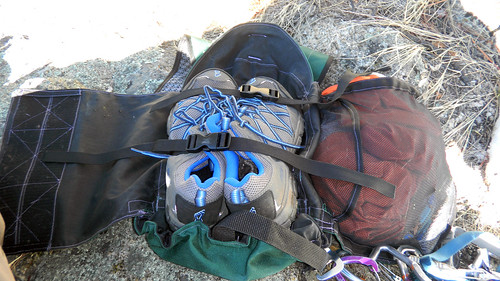
And a shot showing the pack after the first pitch

You can see more pics from the climb
here.
Final Verdict? Pretty sweet. I never felt like it was in the way. In fact, I hardly noticed it at all. It would probably be a bummer in a chimney but what can you do about that? I do wish I would of put a zippered compartment on it somewhere to hold my headlamp and cliff bar. It felt like they could slip out of the jacket pocket when I was pulling out my jacket. The easy solution is to just zip them up in my jacket. In the hotter months I'll probably have to carry water but a smaller bottle like you carry on your bike will fit nicely in the jacket pocket. A little elastic loop may be on order to keep it upright. Also, I wish it had a more convenient handle.








